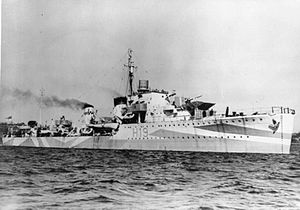HMS Harvester (H19)
 HMS Harvester after 1942 conversion to escort destroyer
| |
| History | |
|---|---|
| Name | Jurua |
| Ordered | 6 December 1937 |
| Builder | Vickers-Armstrongs, Barrow-in-Furness |
| Laid down | 3 June 1938 |
| Fate | Purchased by the United Kingdom, 5 September 1939 |
| Name | HMS Handy |
| Launched | 29 September 1939 |
| Acquired | 5 September 1939 |
| Commissioned | 23 May 1940 |
| Renamed | HMS Harvester, January 1940 |
| Identification | Pennant number: H19[1] |
| Fate | Sunk by U-432, 11 March 1943 |
| General characteristics (as built) | |
| Class and type | Brazilian H-class destroyer |
| Displacement |
|
| Length | 323 ft (98.5 m) |
| Beam | 33 ft (10.1 m) |
| Draught | 12 ft 5 in (3.8 m) |
| Installed power | 34,000 shp (25,000 kW) |
| Propulsion |
|
| Speed | 36 knots (67 km/h; 41 mph) |
| Range | 5,530 nmi (10,240 km; 6,360 mi) at 15 knots (28 km/h; 17 mph) |
| Complement | 145 |
| Sensors and processing systems | ASDIC |
| Armament |
|
HMS Harvester was an
Description
Harvester displaced 1,350 long tons (1,370 t) at
The vessel was designed for four 45-
Wartime modifications
Harvester had her rear torpedo tubes replaced by a
Service
Jurua was ordered by Brazil on 6 December 1937 from
The ship joined the Dunkirk evacuation on 29 May and returned 272 men to Dover during the day. However, the situation at Dunkirk soon became too dangerous to risk the larger and more modern destroyers, so Harvester made no attempt to evacuate any troops during daylight hours on 30 May. This decision was rescinded during the day on 30 May and the ship sailed for Dunkirk on the night of 30/31 May. En route she was narrowly missed by two torpedoes, but she rescued 1341 men in two trips on 31 May and an additional 576 on 1 June.
From July to September, Harvester was assigned to convoy escort duties with the
The ship was refitted at Barrow between 18 March and 18 April and then was assigned to
The ship was refitted at Liverpool between 12 December and 11 February 1943. Whilst defending Convoy HX 228 on 3 March, Harvester forced U-444 to the surface and then rammed it. She was badly damaged by the ramming, but she rescued five survivors after the submarine sank.[12] The next day, Harvester was torpedoed by U-432 and broke in half.[12] Nine officers and 136 ratings were lost, but the French corvette Aconit rammed and sank U-432 herself and then rescued Harvester's few survivors.[12]
Notes
References
- ISBN 978-1-86176-281-8.
- English, John (1993). Amazon to Ivanhoe: British Standard Destroyers of the 1930s. Kendal: World Ship Society. ISBN 0-905617-64-9.
- Friedman, Norman (2009). British Destroyers From Earliest Days to the Second World War. Annapolis, MD: Naval Institute Press. ISBN 978-1-59114-081-8.
- Lenton, HT (1998). British & Empire Warships of the Second World War. Annapolis,MD: Naval Institute Press. ISBN 1-55750-048-7.
- Rohwer, Jürgen (2005). Chronology of the War at Sea 1939–1945: The Naval History of World War Two (Third Revised ed.). Annapolis, MD: Naval Institute Press. ISBN 1-59114-119-2.
- Whitley, MJ (1998). Destroyers of World War Two: An International Encyclopedia. Annapolis, MD: Naval Institute Press. ISBN 0-87021-326-1.
- Winser, John de D (1999). B.E.F. Ships Before, At and After Dunkirk. Gravesend: World Ship Society. ISBN 0-905617-91-6.
